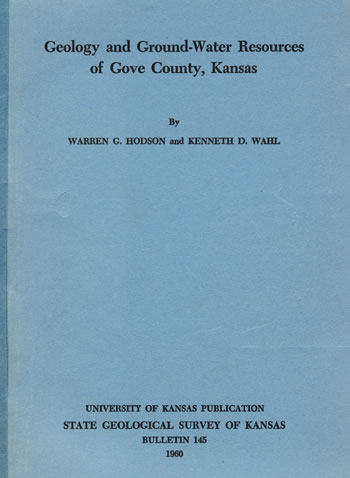Geology and Ground-water Resources of Gove County, Kansas
By Warren G. Hodson and Kenneth D. Wahl

Originally published in 1960 as Kansas Geological Survey Bulletin 145. This is, in general, the original text as published. The information has not been updated.
You may also wish to visit our web site on the Gove County geologic map.
Abstract
This report describes the geography, geology, and ground-water resources of Gove County, in west-central Kansas in the High Plains physiographic section. The county has an area of approximately 1,070 square miles and had a population of about 4,200 in 1957.
The rocks that crop out in Gove County are sedimentary and range in age from Cretaceous to Recent. Chalk beds of the Fort Hays Chalk member of the Niobrara Chalk are the oldest rocks exposed in the county. They are overlain by the Smoky Hill Chalk, upper member of the Niobrara Chalk; the Smoky Hill crops out in much of the southern part of the county. It is overlain by the Pierre Shale, of Late Cretaceous age, which is exposed in a faulted area in the southwestern part of the county but in the northwestern part is found only in the subsurface. Fluviatile deposits of the Ogallala Formation, of Pliocene age, cover most of the northern part of Gove County. Unconsolidated continental deposits of fluviatile and eolian origin represent four stages of the Pleistocene Epoch. Loess classified as Loveland and Peoria Formations, of late Pleistocene age, mantles much of the interstream areas, particularly in the northern part of the county. Alluvium of Wisconsinan and Recent age fills the inner valleys of Smoky Hill River, Hackberry Creek, and Big Creek. Older alluvial deposits, of Illinoisan and Kansan age, dissected and in a high terrace position, occur along the larger streams in the county, chiefly along Smoky Hill River. The surface geology of Gove County is shown by a geologic map; cross sections illustrate the stratigraphic relations of the geologic formations.
Ground water is one of the principal natural resources of the county; most water supplies are obtained from wells. Moderate quantities of ground water are available from the Ogallala Formation and from alluvial deposits in Hackberry Creek and Big Creek valleys. About 1.2 million acre-feet of ground water is in storage in the Ogallala Formation in the northern two-fifths of Gove County. In the southern part, ground water is almost restricted to alluvial valleys. Moderate to large quantities of water are available from alluvial deposits in the Smoky Hill River valley. Only meager quantities, derived mostly from colluvial materials, are available in the interstream areas in the southern part of the county. A few wells in the southeastern part obtain water from the deeper-lying Dakota Formation.
The chemical quality of the ground water is closely related to geologic source, and distinctive types of water are characteristic of each water-bearing formation in the county. Ground water from the Ogallala Formation is fair to good. Water from the alluvium is generally very hard but otherwise suitable for most purposes.
Ground-water pumped for domestic and stock use in Gove County is estimated to be about 800 acre-feet per year. Approximately 500 acre-feet is pumped annually by municipal wells, and an estimated 6,000 acre-feet for irrigation.
Ground-water in the Ogallala Formation in the northern upland moves eastward down an average gradient of about 11 feet per mile. The rate of movement was calculated to be about 0.3 foot per day. The amount of ground water leaving the county underground is believed to be less than that entering the county; much of the difference is accounted for by seepage of ground water from the Ogallala Formation at the contact of the Ogallala on Cretaceous bedrock along Hackberry Creek and Big Creek valleys.
The field data upon which this report is based are given in tables. They include records of 309 wells and test holes, logs of 83 wells and test holes, and chemical analyses of water from 52 representative wells, 4 municipal supplies, and 1 sample from Smoky Hill River.
Kansas Geological Survey, Geology
Placed on web Sept. 30, 2008; originally published June 1960.
Comments to webadmin@kgs.ku.edu
The URL for this page is http://www.kgs.ku.edu/General/Geology/Gove/index.html